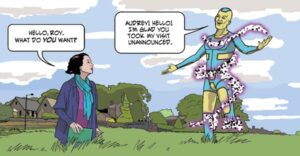Reflect on your current practice and reason about possibilities for development of online and blended learning designs.
I’ve been working on developing a Community of Inquiry (CoI) model for my courses for some time – or Collaborative Inquiry as it is termed. By me.
This is how it’s defined in my Programme’s Handbook:
As part of a unique cohort, you will form a community of practice that establishes and completes a programme of propositional, practical, experiential and presentational collaborative inquiry.
The process of collaborative inquiry may be integrated around any research method or theme that you can agree to focus on. This will be a composite of your personal learning projects.
In a Collaborative inquiry, you will pool your learning resources (established over the first few weeks of this course) and continue to pool your research as you work towards the Art & Open Learning Fair.
It is important to share learning resources that you encounter as much as possible. Share with your Basho (where relevant) and share with the course (where relevant). Pooling and sharing such resources helps to support Collaborative Inquiry.
John Heron and the P2P foundation underwrite my approach here. In my programme, we use the term ‘Collaborative Inquiry’ rather than Heron’s ‘Co-operative Inquiry’ – this is really since collaborative is more commonly used in Art than co-operative, and since Co-operative has (in Scotland at least) strong associations with the Co-operative Movement which are difficult to shake off (not that they are in any way bad associations.) In hindsight, Community of Inquiry (CoI) might be a better way of describing what we are aiming for than Collaborative Inquiry.
Reflect on how you can provide support, facilitation and scaffolding for students in online and blended learning environments.
I do this by creating ‘learning sprints’. ‘Yes, ‘sprint’ is a dodgy ‘design thinking’ cliché, I’m not keen on it either, but it will do as a stopgap for now. The learning sprints are for blended learning on the degree programme I run, but they can (and sometimes do) function entirely online. I applied some of the lessons I learned as founder of Shift/Work to create my own model of the learning sprint for art education (rather than design thinking), situating this in relation to ‘Clean Coaching’, Australian ‘agile schools’ (Breakspear), and the Open Domains movement. My learning sprint model combines organisational learning with learner-centred approaches (such as the Jigsaw Classroom, peer-to-peer production and problem-based learning). The jigsaw and problem-based approaches have proven to be invaluable as a means of decolonising the curriculum.
I wanted to craft my own learning sprint model to rapidly ideate timely disciplines that are open to different ways of thinking and new ideas. For example, in October 2021 I composed a learning sprint called ‘Weird Studies’ – an OER on a speculative ‘scholarly field that doesn’t and can’t exist.’ Imagining an (impossible?) discipline enabled students to gain kaledescopic views of accepted ‘research’ cultures within the academy. The idea here was to investigate non/knowledge boundary formations and gain insight into where and how forms of anti and counter-knowledge – such as current conspiracy theories – are produced, disseminated and challenged.
What does that look like? Well, it’s an OER, so you can try it out yourself here: https://blogs.ed.ac.uk/macat/about/themes-in-contemporary-art-40-credits-semester-1/weirdstudies/ If you pick through this, you will see it contains a nascent Weird-o-Verse of potential forms of weird study or weird subject matter. In spite of how it is presented, in effect, this particular sprint isn’t so dissimilar to the two week, four session ‘Topics’ we have in this ONL course. A happy coincidence!
The Weird Studies? course is a collage of materials that might enable the field to materialise (or not). For example, the bookends of the OER incorporate elements of LARP workshops by The Inter-Actions Group (LUCA School of Arts) and the ARG (augmented reality game) designer Reed Berkowitz: The Wonder Machine and Guided Apophenia from Blend&Bleed: On Transreality and Pervasive Play. Both workshops serve as contemporary exemplars of weird practice that we can all experience through participating in them. It also incorporates a number of writing workshops that I had created. The writing workshops are focused on forms of fabulation and fictioning that I use in my own work.

Image from Chris Lackey’s graphic novel Transreality, 2013 Source: https://www.kickstarter.com/projects/2084279113/transreality
Now, the ‘blend’ aspect of Blend&Bleed is clearly related to how we use ‘blend’ in relation to learning, but for me at least, bleed is more important. The bleed between meatspace and hyperspace is what we should be focused on when it comes to learning design in art. For me, that means trying to create a post-studio programme that is open (OER) yet is able to mix analogue and digital in ways that don’t just lapse back into augmented reality or skeumorphic soup du jour. Speculative play is crucial, and bleeding invites this.
My aim is to keep developing my own collections of sprint learning and making tools that we can take out of the ‘classroom’ or studio and keep working with at home and/or away. There’s not much point working with tools that are only ever available in the campus ‘classroom’ or studio if you want to figure out how to integrate art with the wider world around us (a transreality that is bleeding). Moreover, a post-studio practice is one that has to be able to function without (over) relying on the studio/workshop environment…
Are there opportunities for further development in this area that you have identified as a result of your own experience as a learner in the ONL course and of your engagement in this topic?
Coming back to happy coincidence re: two-week learning sprints – this has led me to have lots of ideas for further development of the my own post-studio model of learning sprint. One thing I’d like to use more of are the prompts for critical reflection (like the one I am responding to right now). They help as signposts to the learner, enabling them to report back on what they are engaging with, and what does not engage them. I want to use prompts in a way that is compatable with Jesse Stommel’s approach to ungrading:
Currently I have students write self-evaluations two to three times throughout the term. The first of these is usually more directed (with specific questions) than the last (which opens into something more like an essay). What students write to me in these self-evaluations is profoundly different from the kinds of interactions we would have in a purely transactional system. Their self-evaluations (which I sometimes call “process letters”), and my responses to them, become a space of dialogue, not just about the course, but about their learning and about how learning happens. (Stommel 2020: 35)
So, Stommel asks his students to account for the work they have done. The more they learn, the more they can self-review. But it’s not simply ‘reporting’, or clocking-in, it’s an open dialogue. A semi-structured or loosely scaffolded series of blog post suggestions (as used here in ONL) perhaps works in a similar way? ONL has no grades and certifies students with a ‘pass’ if they complete the work. There’s no ‘busywork’ (Stommel 2020: 29) that has to be done for the sake of looking productive – we do things only if they enable us to learn something. That’s how it should be and that’s an approach I am going to implement in all of my courses.
For more on this, listen to: Ungrading with Susan Blum What’s the Big Idea? https://podcasts.apple.com/gb/podcast/ungrading-with-susan-blum/id1457632377?i=1000557508177
It’s worth noting that even though ONL has largely removed the ‘reporting’ and busywork elements associated with formal learning via a (quasi-)accredited course (elements that are invisible in my PBL group), I heard through the grapevine that the desire/need to ‘clock-in’ in a quantifiable way remains a point of contention in other PBL groups. It might be that there’s a pressing need to ‘pass’ the ONL course the missing gradebook generates anxiety here. I can understand where these feelings comes from; but it seems better than suffering from grade-anxiety. Paraphrasing Peter Elbow, Stommel describes
a “zero scale,” in which some work is assigned but not collected at all. This frees teachers from feeling they have to respond to, evaluate, or even read every bit of work students do. And this last, moving away from student work as a thing to be collected, might prove best at creating intrinsic motivation to do the work of a course. (Stommel 2020: 37)
ONL, effectively, operates a zero scale. Student work can be submitted, but it’s not ‘collected’ as such and isn’t ‘weighed’ or graded. This is what makes ONL a potentially transformative (rather than transactional) form of learning. If the motivation to write these words were not there then…., well….
Further reading:
Berkowitz, Reed. ‘A Game Designer’s Analysis Of QAnon: Playing with reality‘, Curiouser Institute, https://medium.com/curiouserinstitute/a-game-designers-analysis-of-qanon-580972548be5
Breakspear, Simon. Learn the Agile Leadership essentials https://agileschoolleadership.com/
Bloom, Susan. ‘Ungrading with Susan Blum’ What’s the Big Idea? https://podcasts.apple.com/gb/podcast/ungrading-with-susan-blum/id1457632377?i=1000557508177
Kohn, Alfie, and Susan D. Blum. Ungrading: Why Rating Students Undermines Learning (and What to Do Instead). First edition. ed., Morgantown: West Virginia University Press, 2020. muse.jhu.edu/book/78367.
Heron, John. Co-operative Inquiry: Research into the Human Condition, London, Sage Publications, 1996. http://www.human-inquiry.com/doculist.htm
Lackey, Christopher Jon. Transreality, Witch House Media UK, 2013
Mulholland, Neil. ‘Collaborative Inquiry.’ https://blogs.ed.ac.uk/macat/contemporary-art-open-learning-course-handbook-semester-1/collaborative-inquiry/
Mulholland, Neil. ‘Speculations on post-studio practice.’ blogs.ed.ac.uk/macat/2020/02/10/what-is-post-studio-practice/
Mulholland, Neil. ‘Weird Studies?: Learning Sprint’ blogs.ed.ac.uk/macat/about/themes-in-contemporary-art-40-credits-semester-1/weirdstudies/
P2P Foundation, Cooperative Inquiry, https://wiki.p2pfoundation.net/Cooperative_Inquiry
Stommel, Jesse ‘How to Ungrade‘ in Kohn, Alfie, and Susan D. Blum. Ungrading: Why Rating Students Undermines Learning (and What to Do Instead). First edition. ed., Morgantown: West Virginia University Press, 2020. muse.jhu.edu/book/78367. pp. 23-41
Stommel, Jesse. Ungrading, an Introduction. www.jessestommel.com/ungrading-an-introduction/ 11 Jun 2021

